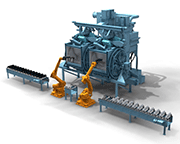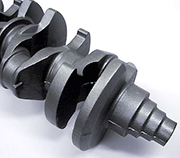E-Archive
Articles
in Vol. 17 - May Issue - Year 2016
Planning Ahead: Crankshaft Production Doubled with Second Blast Machine

A Wheelabrator DV-4, installed in 2008, was joined by a sister machine in July 2015. Together, the two machines process up to 720 crankshafts per hour.

Crankshaft
Bharat Forge CDP has doubled production at its facility in Ennepetal, Germany, following the deployment of a second manipulator blast machine.
Commissioned in July 2015, the Wheelabrator DV-4 machine was installed next to its almost identical sister machine, which had been in operation for seven years. The two lines achieve an annual production of 1.2 million crankshafts each.
Due to their multiple-chamber design, DV-4 machines allow loading and unloading during the blast cycle, keeping non-productive time to a minimum.
Whilst still fairly new to the forging industry, the concept (see image) is increasingly popular, particularly for automotive applications, thanks to short cycle times (18s on average), a high degree of process control, and high level of automation.
Around 360 crankshafts for cars and motorcycles per hour and machine are now processed at BF CDP - reliably, repeatebly, continuously.
Wolfgang Försterling, Technical Sales at Wheelabrator in Zürich, explains: "The slightly unusual aspect of this project was that, in anticipation of future increases in production, BF CDP had asked us to plan for the second machine right back in 2008, when we were designing the first one. When the second line was due this year, its specification had long been decided. However, we were able to use latest technologies and make a couple of improvements, based on learnings from the first machine and its seven years in operation."
The various improvements have reduced maintenance requirements and operating cost of the new machine drastically. Direct-drive blast wheels, frequency inverters and magna valve mean fewer wear parts due to fewer movable parts; optimised wear plates last longer; direct-drive blast wheels save energy. All these improvements can now also be applied to the older line, as part of strategic equipment modernisation (EMP).
In terms of speed of installation, the new machine wins by a country mile. The two barrels that form the blast chamber of the new machine were designed as two segments each, which simplified transport and installation due to reduced weight and size of individual machine elements. The machine is also set up flush with floor level, rather than needing complex foundations.
Rüdiger Muylkens, Plant Manager at Bharat Forge CDP, adds: "For decades, we have been working closely with Wheelabrator experts in Metelen and Zürich. This partnership approach has always worked for us, but it's really paid off on this project, allowing us to plan for the long-term, but act quickly when we needed to. The commissioning of the line went incredibly smoothly, exactly according to time plan and without impacting on running production. The fact that we were building on the concept of the trusted first line took a lot of risk out of the equation and delivered a machine that is perfectly tailored to our production environment."
For Information:
Viktor W. Lussi, Sales Director
DISA Industrie AG (Wheelabrator Group)
Kasernenstrasse 1
8184 Bachenbülach, Switzerland
Tel. +41.44.815 4000
Fax +41.44.815 4001
E-mail: zurich@wheelabratorgroup.com
www.wheelabratorgroup.com



























